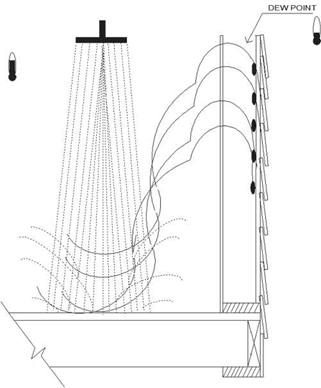The bathroom is a major source of moisture within a home—showering, soaking in the bathtub, running water in the lavatory, water evaporating from the toilet bowl, towels drying. In a new bathroom, many building products such as grout, joint compounds, plaster, and latex paints also contain water. These products dry and cure, and water vapor is released.
Even in a very dry climate, excess moisture inside a building structure can lead to serious problems.
Prevention of moisture problems within the bathroom is part of the designer’s responsibility. The designer needs to consider problems that might occur throughout the home due to moisture generated in the bathroom. The designer’s goal should be to make it as easy as possible to control moisture in the bathroom, and to minimize the potential for problems from moisture that is not controlled.
Excess moisture is a potential problem for both the building and the people who live in it. Excess moisture in building materials leads to structural problems, such as peeling paint, rusting metal, and deterioration of joists and framing. Damp building materials tend to attract dirt and therefore require more cleaning and maintenance.
Damp spaces make good environments for the growth of many biological pollutants. Bacteria and viruses thrive, as do pests from dust mites to cockroaches. Wet building materials can also harbor mold, which leads to further structural damage. Mold can be a health threat. In addition, mold growing on interior finish materials smells bad and is ugly.
 |
The cycle of water evaporating and condensing in a bathroom can lead to moisture problems. A bathroom tends to be warmer than other parts of the home, which is desirable as it increases the comfort level when someone is naked or wet. However, because they are warmer, bathrooms tend to have higher humidity.
Many bathroom activities, such as showers and baths, further increase the temperature of the air as well as the moisture level. However, materials and surfaces in the bathroom tend to be cooler
 |
 |
than the air—which leads to condensation. In addition, when the user finishes showering or bathing, the room tends to cool down, leading to more condensation.
Wet materials result in increased maintenance, and eventually, deterioration. This is especially true of any that are absorbent and stay damp, such as drywall and textiles.



